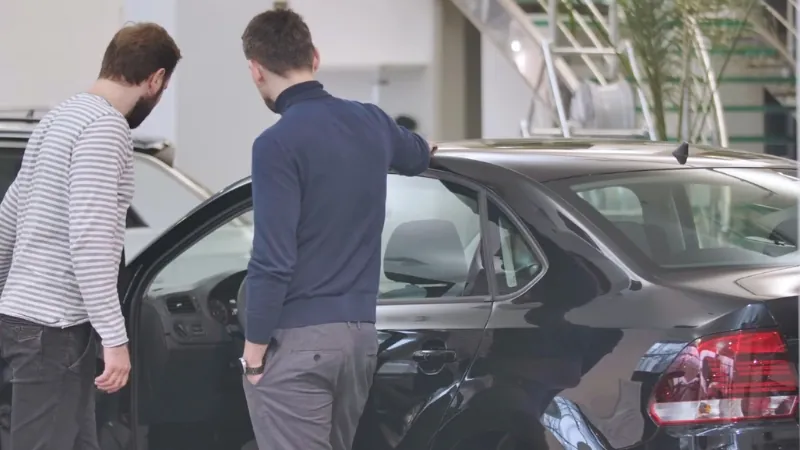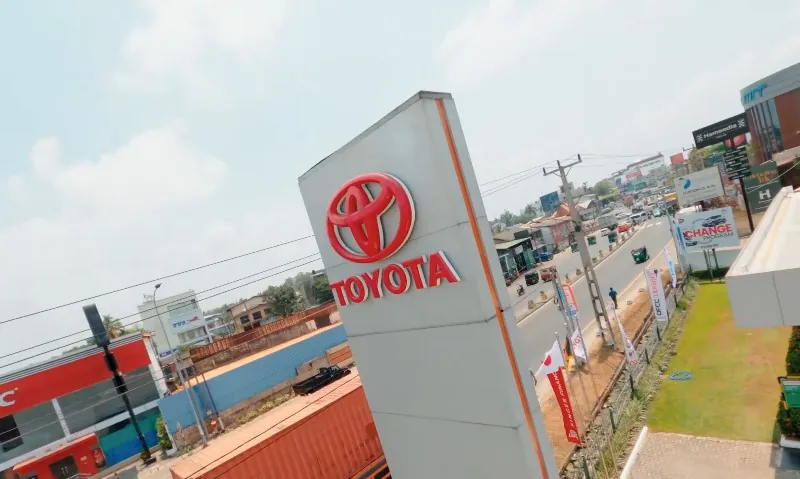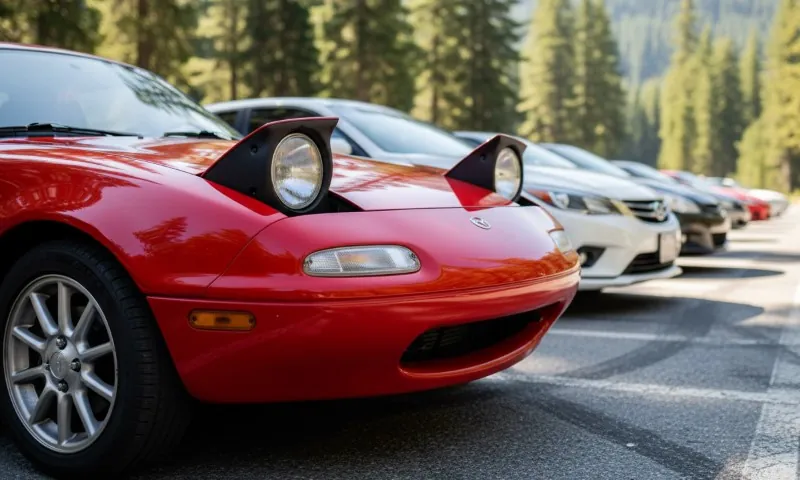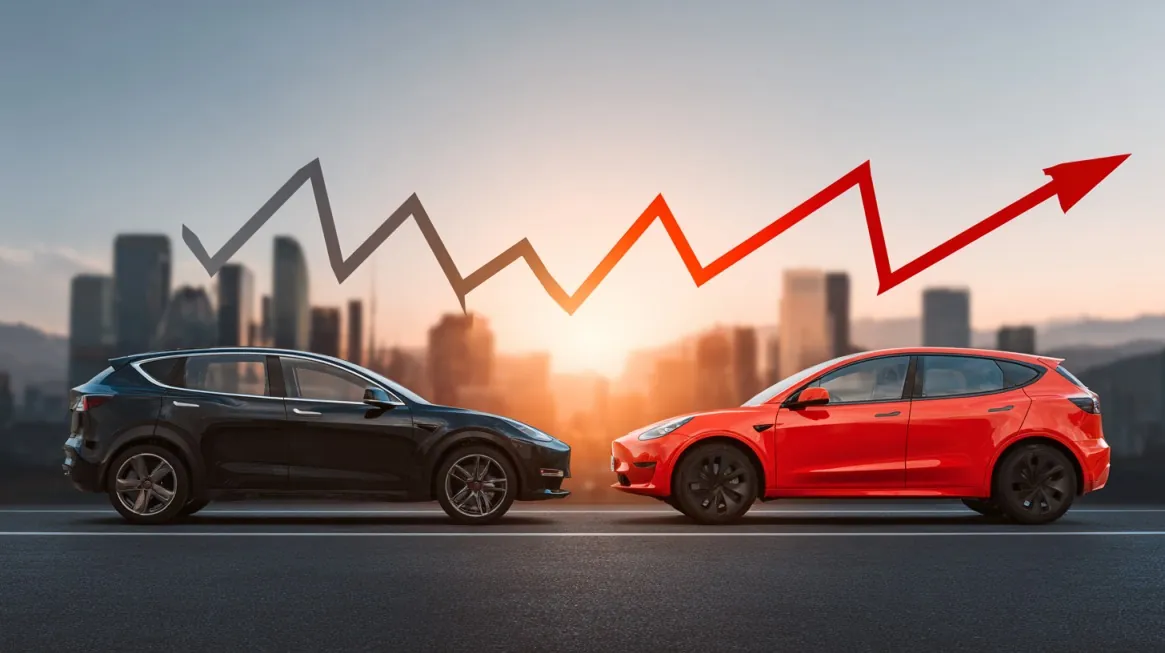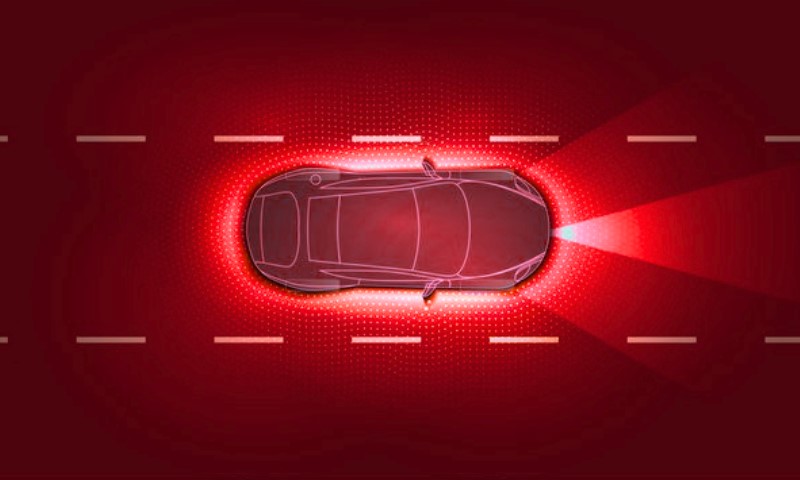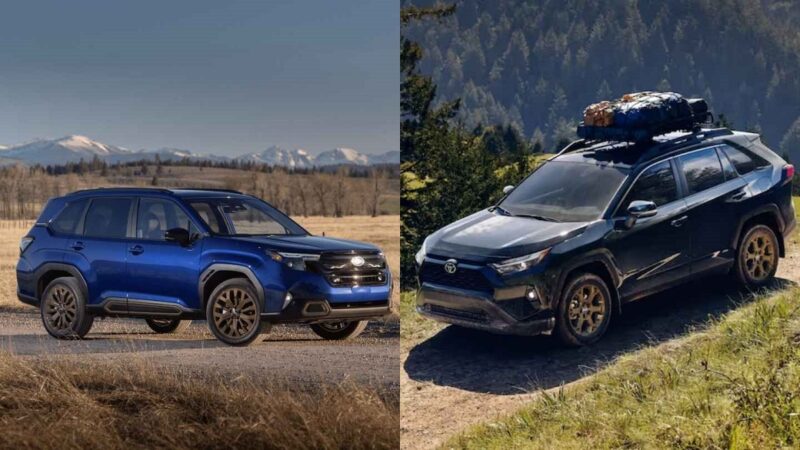
Share Post:
Sometimes, people hunting for a well-rounded compact SUV arrive at a crossroads: Subaru Forester or Toyota RAV4. Both are heavy-hitters and carry strong reputations for quality and reliability. Each has unique strengths, and plenty of data points nudge the decision in various directions.
No one wants to end up with regrets after signing paperwork at a dealership, so it helps to take a close look at real numbers, features, and day-to-day impressions. Grab a cup of coffee, get comfy, and let’s map out what the Forester and RAV4 bring to the table.
Table of Contents
ToggleA Quick Reference Table
| Feature | Subaru Forester | Toyota RAV4 |
| Starting Price | $29,995 | $29,250 |
| Top Trim Price | $41,715 | $37,555 |
| Horsepower (Base Engine) | 182 hp, 178 lb-ft torque | 203 hp, 184 lb-ft torque |
| Drivetrain | Standard AWD | FWD Standard (AWD Optional) |
| Fuel Economy (City/Hwy, AWD) | 26/33 mpg | 26/33 mpg |
| Cargo Space (Seats Up) | 29.6 cu ft | 37.5 cu ft |
| Max Cargo (Seats Folded) | 74.4 cu ft | 69.8 cu ft |
| Safety Features | EyeSight (standard) | Toyota Safety Sense 2.5 (standard) |
| Infotainment | 7″ or 11.6″ display, CarPlay & Android | 7″ or 10.5″ display, CarPlay & Android |
| Best For | Off-Roading, Winter Roads | On-Road Driving, Efficiency |
Price Range
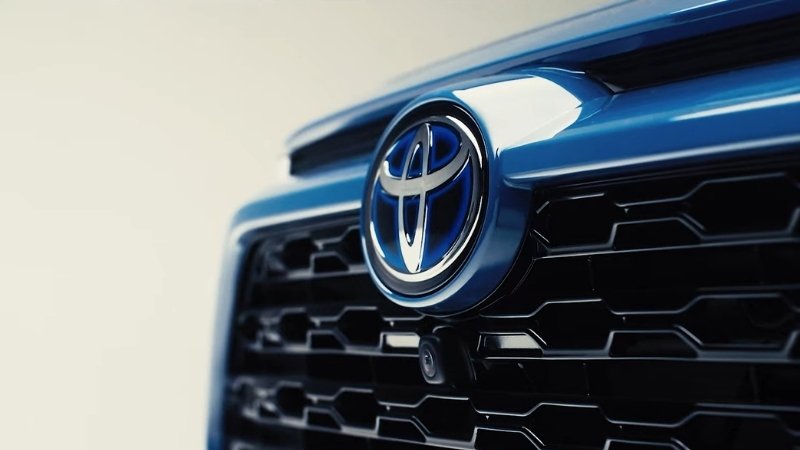
Cost can be the very first filter people consider, so it’s smart to scope out pricing early on.
- 2025 Toyota RAV4: Starts around $29,250 (base trim) and climbs to roughly $37,555 for top-tier editions, as per Toyota’s official website.
- 2025 Subaru Forester: Opens at $29,995 for the entry trim and extends to about $41,715 for the highest spec, as per Kelley Blue Book.
That suggests RAV4 might be slightly kinder to a buyer’s wallet in base form. Meanwhile, Forester’s top trim creeps a bit higher, which could matter for individuals who crave all the bells and whistles.
Still, real-world pricing sometimes depends on dealer incentives, market conditions, and random local promotions, so exact numbers can vary.
Engine Output
- RAV4: Equipped with a 2.5-liter four-cylinder boasting 203 horsepower and 184 lb-ft of torque.
- Forester: Fitted with a 2.5-liter Boxer engine putting out 182 hp and 178 lb-ft.
Those figures mean RAV4 edges ahead in sheer power. It’s not a night-and-day difference, but people who love a little extra pep might find the Toyota more sprightly around town.
Forester’s no slouch, yet the emphasis feels slightly more on balanced capability than raw punch.
Drivetrain Options
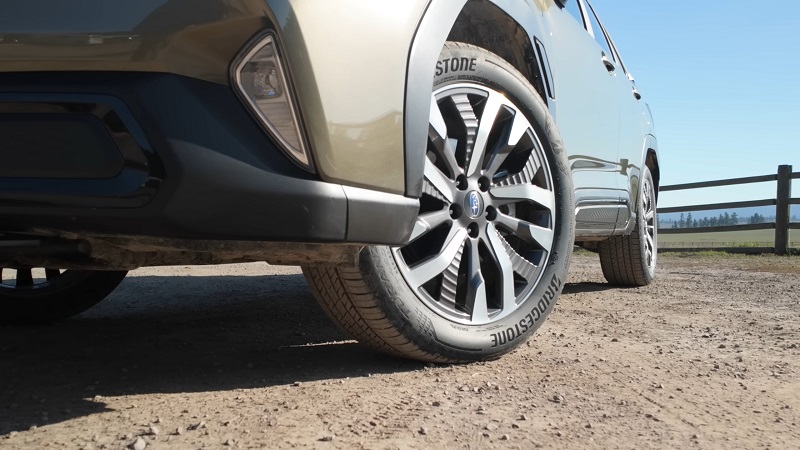
- Forester: Standard Symmetrical All-Wheel Drive (AWD).
- RAV4: Front-wheel drive is standard, AWD is available (for about $1,400 extra, depending on the trim).
One brand built a reputation on AWD, and that’s Subaru. Standard AWD keeps traction locked in no matter rain, snow, or a less-traveled gravel road. It’s part of the Subaru identity—perfect for outdoor lovers who crave stable footing without an added fee.
RAV4’s optional AWD is perfectly capable, but some might prefer it baked into the price instead of paying more.
Fuel Efficiency
- Forester: EPA estimates land around 26 mpg city / 33 mpg highway (with AWD).
- RAV4: Hits 27 mpg city / 35 mpg highway with front-wheel drive, then about 26/33 if AWD is chosen.
Anyone chasing maximum mileage might lean toward a front-wheel-drive RAV4. Once both SUVs have AWD, they practically tie. If AWD is non-negotiable, the Forester’s numbers remain quite competitive.
And for those craving better fuel economy, RAV4’s hybrid versions (and the plug-in hybrid Prime) bring some enticing mpg figures.
Subaru fans keep eyeing announcements about a Forester hybrid, but widespread availability remains a work in progress as of early 2025.
Interior Space
Cargo Volume
- RAV4: 37.5 cubic feet behind the second row, 69.8 cu ft total with seats folded.
- Forester: 29.6 cubic feet behind the second row, 74.4 cu ft total with seats folded.
A quick glance at those numbers reveals a classic “you win some, you lose some” scenario. RAV4 stands out if the back seats need to stay upright all the time, creating that extra chunk of cargo space for groceries, sports gear, or random Costco runs.
On the other hand, folding those seats in a Forester unlocks a cavernous interior that beats RAV4 by a fair margin, which is a big deal for people who lug around furniture or piles of camping gear.
Passenger Comfort
Forester enthusiasts often praise its airy vibe, partly due to ample rear legroom. Tall passengers can settle in without worrying about knees hitting seatbacks.
RAV4 remains quite comfortable too, but a measurement tape typically shows a slight advantage in certain dimensions for Subaru’s interior.
Anyone who’s had a six-foot friend riding in the back seat on a road trip can appreciate that difference.
Tech and Infotainment
Subaru Forester
- Standard 7-inch touchscreen with an option for an 11.6-inch upgrade.
- Wireless Apple CarPlay and Android Auto.
- Subaru EyeSight suite of driver-assist features (adaptive cruise control, lane departure alerts, and more).
In our previous blog, we explained what to do if Apple CarPlay isn’t working in your Subaru. Maybe it’s the right time to check it out.
Toyota RAV4
- 7-inch touchscreen as standard, with a 10.5-inch option on higher trims.
- Wireless Apple CarPlay and Android Auto as well.
- Toyota Safety Sense 2.5 (pre-collision alerts, lane tracing, traffic sign recognition, among other functions).
Each brand ensures a modern connectivity experience. Apple CarPlay and Android Auto free people from fumbling with cords (if they choose the right trim levels).
Voice command features, optional premium audio setups, and advanced driver-assist features keep either SUV modern and safe.
Subaru’s EyeSight and Toyota Safety Sense both earn strong marks from safety evaluators, so a trip to the supermarket or a cross-country excursion should feel well-supported on either side.
Safety Ratings
Both nameplates score high in crash tests conducted by organizations such as the Insurance Institute for Highway Safety (IIHS) and the National Highway Traffic Safety Administration (NHTSA).
Subaru’s EyeSight technology is widely praised for its forward collision mitigation, lane-keeping support, and other preventive features.
Toyota’s Safety Sense 2.5 package is in the same league. Neither brand is cutting corners when it comes to occupant protection.
Driving Feel (City Streets vs. Dirt Paths)
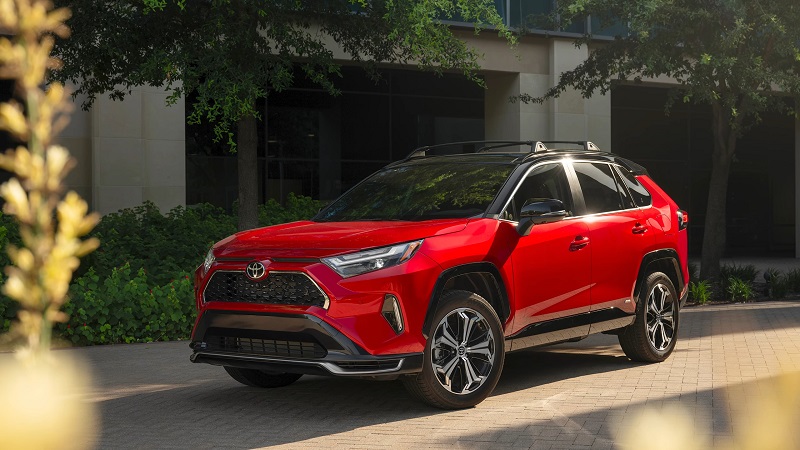
Some drivers find the Forester feels at home on rough trails or slippery winter roads, thanks to its standard AWD and higher ground clearance.
The Wilderness trim amps up that rugged appeal even more, making it a go-to for people who live off the beaten path (or daydream about it).
RAV4 can hold its own in less-than-ideal conditions if equipped with AWD, and many owners swear by its confidence on highways and city streets.
Its ride is generally smooth, with enough pep for casual everyday travel. However, the newest lineup dropped a few off-road-oriented trims, which might matter to people who want a chunkier look or dedicated features for tackling rocky campsites.
Ownership and Warranty
Both Subaru and Toyota typically offer:
- 3-year/36,000-mile basic warranty
- 5-year/60,000-mile powertrain warranty
That coverage ensures a reassuring safety net for routine repairs. Maintenance costs for either brand usually rank as fairly reasonable in the grand scheme of automotive ownership, and reliability scores remain among the best in the segment.
It helps that both the Forester and RAV4 have a storied history of hitting impressive mileage marks without fuss.
Additionally, both Subaru and Toyota provide rust perforation coverage for 5 years, with Subaru offering unlimited mileage and Toyota’s mileage limit varying by region, according to Market Watch Guides.
Toyota also offers an 8-year/100,000-mile warranty on hybrid-related components and a 10-year/150,000-mile warranty on hybrid batteries for models from 2020 onward.
Off-Road vs. On-Road
1. Weather Challenges
- Live in a region with snow and ice from October to April? Forester’s standard AWD stands out.
- RAV4’s available AWD still offers security, but the Subaru approach is baked in from the start.
2. City-Dweller Priorities
- If daily commutes involve busy freeways and parallel parking, RAV4’s front-wheel drive might be enough (along with slightly better MPG in that configuration).
- Forester remains agile too, though its AWD focuses on surefooted traction over raw efficiency.
3. Cargo Shuffle
- Keep seats upright most of the time for gear or groceries? RAV4’s 37.5 cu ft is bigger than Forester’s 29.6.
- Need to haul big furniture pieces or occasional long items? Forester’s fold-down cargo area surpasses RAV4 at 74.4 cu ft vs. 69.8.
My Take After Driving Both
From the vantage point of someone who has spent countless hours test-driving SUVs, each option projects a distinct personality:
- Forester: Feels a bit like that reliable friend who’s always game for a weekend getaway up in the mountains—organized, stable, and surprisingly spacious once you look around inside.
- RAV4: Lives up to Toyota’s legacy of smooth powertrains and minimal fuss at the pump. The brand’s hybrid offerings add an eco-friendly angle for people who love skipping the gas station.
Talking with owners reveals a common theme: both rank high on comfort and user-friendly tech.
One might see the Forester in a ski-resort parking lot or campsite, while RAV4 is busy zipping through a suburban commute, though each can handle a bit of the other’s territory.
They’re not locked into stereotypes; they just have different strengths.
Summary
A side-by-side showdown is always helpful when two popular SUVs lock horns on paper. In many cases, it boils down to lifestyle needs and personal preferences.
Forester is the champ for standard AWD, plus that unbeatable maximum cargo space. RAV4 slides in with a lower base price, slightly stronger engine, and impressive mpg if front-wheel drive suits the driver. Neither selection is a bad move.
Both arrive loaded with safety features, refined interiors, and proven reliability records. In the end, it’s all about whichever box gets ticked in your daily routine and weekend adventures.
Drivers hoping to handle gnarly winter roads and backcountry trails might find Forester calling their name. Fans of a bit more pep, front-wheel drive savings, or hybrid configurations might gravitate toward RAV4.
Taking a test drive and giving each a feel is the best bet for final confirmation. The tie-breaker could be the vibe behind the wheel—some people just click with one brand or the other.
Related Posts:
- How to Choose the Right Tires for Your EV - Complete Guide
- Full Guide to Choosing the Right Car Accessories by Season
- RSA Toyota Meaning - How It Keeps You Safe
- Worst Toyota 4Runner Years (And Why You Should Skip…
- Subaru Dashboard Warning Lights - What Every Driver…
- Subaru CarPlay Not Working: 5 Common Reasons & Solutions




